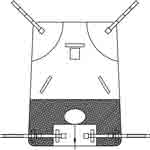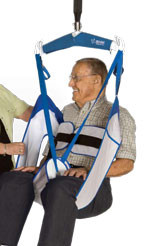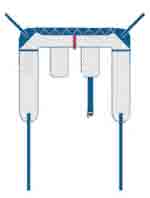Ceiling Lift Sling Information - Page 2
Hammock Slings

BHM Hammock Sling

Prism Hammock Sling
The hammock sling design predates the universal sling design and was at one time the most commonly used sling for many types of patient lifts. The hammock slings are basically a full sheet of material that fits from just above the knees to the back of the head. The hammock sling is used for people who need more support than they can get from a universal sling.
Hammock slings, without a great deal of difficulty, can not be put on or taken off a user when they are sitting in a wheelchair. The user normally has the hammock sling put on when laying flat and then, if they use a wheelchair, have to sit on the sling all day. For most people this isn't too big a problem but for people where skin breakdown and pressure sores are a concern, sitting on the sling will reduce the effectiveness of their wheelchair cushion.
Hooking Up The Sling
Hammock slings are normally put on by laying the user on their side while in bed and tucking half the sling under them. They are then rolled back and up on the other side and the the sling is pulled through. At this point the user can roll onto their back have the sling will be under them. The straps are then hooked onto the lift and the user can be lifted up to a sitting position using the lift.
As with the universal sling, the angle the user sits when lifted can be determined by how the straps are hooked up. Shorter on the shoulder straps and longer on the leg straps will put the user into an upright position. Longer on the shoulder straps and shorter on the leg straps will recline the user.

BHM Hygiene Sling

BHM Hygiene Sling
Hygiene Sling
The hygiene slings are another popular choice for slings (especially in nursing homes and hospitals) and are intended to be used for toileting and cleansing. The intent of the design of the hygiene sling is such that the user's clothing can be undone and moved out of the way during toileting.
They are very minimalist and give very little support but while they are designed to securely hold the user they are intended for very short use and not very comfortable for extended periods of time. If one took a universal sling and cut out much of the back material they would have the basic hygiene sling.
To reduce the discomfort, caused by the minimal size of the sling, most manufacturers add padding to the areas of the sling where it may become uncomfortable for the user.
Chest Strap
Because the hygiene sling has so little material and some security is lost due to the small back area the manufacturers usually add a chest strap to the sling for added safety. These chest straps are usually between 4" and wide and may be padded. They have an adjustable locking belt so they can be secured snugly around the lower chest area.


 Online Vendors
Online Vendors  US Online Vendors
US Online Vendors 